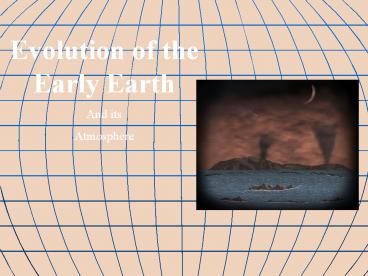Evolution of the Early Earth - PowerPoint PPT Presentation
Title:
Evolution of the Early Earth
Description:
Title: PowerPoint Presentation Author: Stacy - McGraw-Hill Higher Education Last modified by: greg Created Date: 6/16/2003 2:59:31 PM Document presentation format – PowerPoint PPT presentation
Number of Views:107
Avg rating:3.0/5.0
Title: Evolution of the Early Earth
1
Evolution of the Early Earth And its Atmosphere
2
Fig. 6.3
Stages in Planetary Evolution
1. Planetesimals small bodies formed from dust
and gas eddies 2. Protoplanets 9 or 10 formed
from planetesimals accretion 3. Planets formed
by combining protoplanets swept up by
gravitational attraction. 4. Left over debris
craters newly formed planets
3
Fig. 6.4
Stages in Formation of Early Earth
. From (A) a homogeneous, low-density protoplanet
to (B) a dense, differentiated planet
4
Differentiation of Chemical Elements in Earth
Present distribution of major elements and U, Th,
He and Ar in the Earths atmosphere, crust and in
seawater. (Elements listed in order of abundance).
5
Earth is internally heated mostly by the decay of
Uranium 238 and Potassium 40 eventually U-238
(R-process element) dominates
6
Divisions of the Earth's interior
Cross section of Earth showing in a rudimentary
way the relation of the upper mantle to
subduction zones and midocean ridges. Internal
heating eventually drives plate tectonics.
7
The First Atmosphere
- The early atmosphere would have been similar to
the Sun--mainly hydrogen and helium, but this
atmosphere was lost quickly for two reasons - (1) The gravity of the modest size earth was not
strong enough to prevent such light gases from
escaping to space. Particularly since the early
earth was hot! - (2) It appears that around 30 million years
after the earths formation, it was struck by a
large objectthe size of Mars. The result the
origin of the moon and loss of earths early H,
He atmosphere.
8
Hadean is name given to Eon in which Earth
formed by accretion and meteorite bombardment. It
was truly hell on earth as constant meteorite
bombardment and high interior heat flow combined
to keep early Earth surface in nearly constant
molten state.Atmosphere of early Earth likely
reducing (i.e. no oxygen) and similar to present
Jupiter atmosphere (?), mostlyThe first
atmospheremethane (CH4), ammonia (NH3),
hydrogen (H2) and helium (He)
9
The Second Atmosphere
- Volcanic Out-gassing radically changed the
chemical composition of the atmosphere
10
Earths Second Atmosphere
- A new atmosphere was established by the outgasing
of volcanoesthe mixture of gases was probably
similar to those of todays volcanoes - H20 vapor (roughly 80)
- CO2 (roughly 10)
- N2 (few percent)
- Small amounts of CO, HCL, HS (Hydrogen Sulfide),
SO2, CH4 (Methane), Ammonia (NH3), and other
trace gases.
Water vapor about 60-80 of total emission
carbon dioxide 10-30
11
Earths Second Atmosphere
- Virtually no oxygen in that second atmosphere.
- Thus, no ozone layer, so ultraviolet radiation
flooded the earths surface. - With a huge influx of water vapor and the cooling
of the planet, clouds and earths oceans formed
over a period of 300-700 million years. Banded
iron formations dated at 3.8 billion years
indicate oceans were in place. - At that time the sun was about 30 weaker than
todaywhy didnt the earth freeze over? - The apparent reason so much CO2 so there was a
very strong greenhouse effect. - But have to get rid of the CO2 so conditions
favorable to life can exist
12
Chemical Weathering
- H20 CO2 --gt H2CO3 carbonic acid
- CaSiO3 H2CO3 --gt CaCO3 SiO2 H20
- Silicate Rock Carbonate
- Oceans dissolve most of the CO2
- Marine organisms would eventually incorporate
carbonate into their shells, which would fall to
the ocean bottom when they died---thus, removing
them from the system for a long time. - The bottom lineCO2 was being removed from the
system over the course of a few hundred million
years
13
More Changes
- Sulfur compounds were taken out of the atmosphere
as acid rain and were deposited on the ground as
sulfates. - N2 gas increased slowly but progressively since
it was relatively inert. - Current composition of the atmosphere was
established approximately a billion years ago.
14
The Rise of Oxygen and the Third Atmosphere
- In the first two billion years of the planets
evolution, the atmosphere acquired a small amount
of oxygen, probably by the splitting of water
(H20) molecules by solar radiation. - The evidence of this oxygen is suggested by minor
rust in some early rocks. - The oxygen also led to the establishment of an
ozone layer that reduced UV radiation at the
surface. - With the rise of photosynthetic bacteria
(cyanobacteria) and early plants, oxygen levels
began to rise rapidly as did indications of rust
in rocks - Between 2.5 billion years ago to about 500 bya,
02 rose to near current levels.
15
Overall, we have to wait about 2.5 billion years
from formation to the first signs of oxygen in
the atmosphere Fe dissolved in the oceans
(thanks to supernova) scavenge the O2 for 2
billion years until saturation.
16
Evolution of Life































